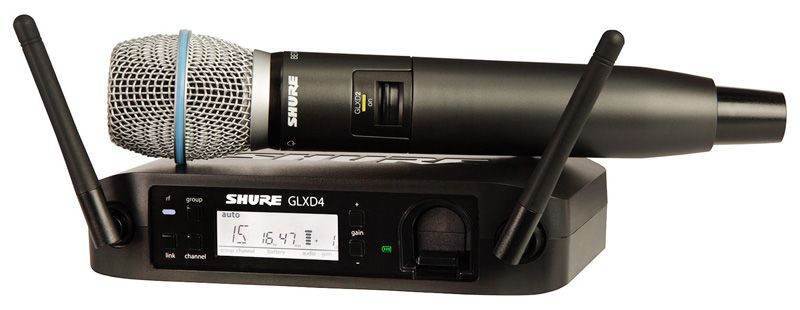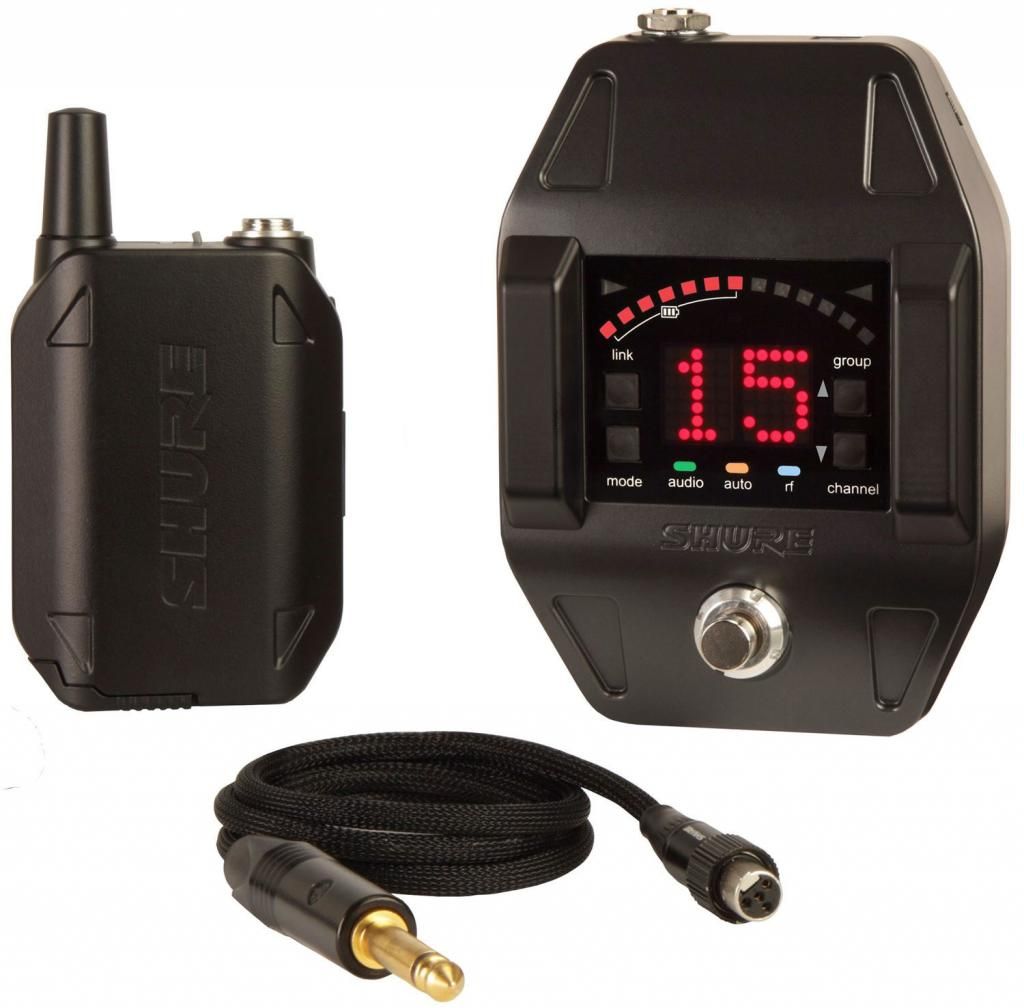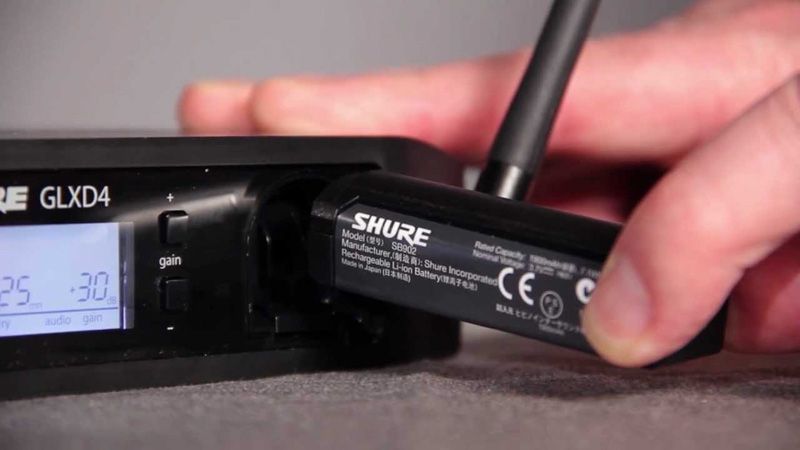
The Shure GLXD digital wireless microphone system combines intelligent technology and smart power options into a compact, cost-effective package. The system operates in the 2.4 GHz band and offers automatic frequency management as well as rechargeable transmitter batteries. Transmitter options include handheld units equipped with SM58, SM86, Beta58A or Beta87A mic elements, belt pack transmitters that can be used with a variety of lavalier and headset mics, and instrument mics and a cable for backline applications.
Up to four compatible systems can operate together in a standard setting, with up to eight systems maximum in optimum conditions. The stated operating range of the transmitter for indoor usage is up to 100 feet typical, with a maximum distance of 200 feet from the receiver under ideal conditions. Outdoors, up to 65 feet is typical, with a maximum distance to the receiver of about 165 feet under ideal conditions. The maximum use time for the continuous rechargeable transmitter battery is stated as 16 hours.
The Overview
Out of the box I was pleasantly surprised to find that the system ships with a sturdy foam-lined soft sided zippered case that holds all the components and has room for some accessories. The specific system I evaluated consisted of a GLXD2 handheld transmitter with a Beta87A supercardioid condenser mic element with a standard GLXD4 receiver. (There is also a nifty GLXD6 wireless guitar pedal -- an all-metal receiver with built-in tuner that's available for musicians.)

The GLXD4 receiver has a rugged yet lightweight half-rack-sized body with two permanently attached antennas on the front. A large screen flanked by a few push buttons allow the user to easily configure the system as well as monitor status of frequencies/channels, audio signal from transmitter, battery life of transmitter, and system gain. A battery charging bay is also situated on the front (more on this later).
The rear of the receiver offers both XLR and 1/4-inch output connectors, a power switch, DC power input on a locking (thank you!) jack, and a USB port for uploading firmware updates. The power cord is of the “lump” style that places the transformer in the middle of the cable instead of the “wall wart” style that places it at the plug end. I prefer this style of cable because it lets me use a regular power strip and also allows for a cleaner rack cable scheme because I can securely mount the “lump” to the side wall of a rack with a few screws.
The GLXD2 handheld transmitter has a rugged plastic body with a large side-mounted (and recessed switch), and status LED. The LED changes colors and flashes to indicate different conditions. During normal operation the LED glows green, while flashing green indicates the transmitter is searching for or linking with a receiver. A steady red light indicates about one hour of battery life is left, and flashing red tells the operator that only about a half hour of battery life remains. An amber light signals that there is a battery error.
A very useful feature to help a user identify which mic is linked to a specific receiver is called Remote ID. Pressing a button on the receiver causes the LED to flash red and green on the transmitter, easily identifying the unit you're looking for. Another handy feature is that the power switch on the transmitter can be configured to operate normally or be locked so that it will not turn the transmitter off one it has been turned on.
GLXD transmitters are powered by Shure SB902 lithium-ion rechargeable batteries that are stated to have zero memory effects, eliminating the need to discharge batteries prior to charging. Charging can be accomplished when the battery is inside a transmitter or when removed.
When installed, the included USB cable can be connected to a computer or wall outlet or car adapter. The battery can also be inserted into the receiver’s charging bay, and a spare battery can be kept inserted in the bay during use. While a spare battery is always a good idea when using wireless equipment, it should not be needed with the GLX system as the manual states that a 3-hour charge using the receiver battery bay results in up to 16 hours of continuous usage.

A partial charge of 1 hour provides up to 6 hours of use, and even quick charges of 15 and 30 minutes give respectable usage times of up to 1.5 and 3 hours, respectively. The battery is rated for up to 10,000 hours of use before needing to be replaced. While I’ve not been a big fan of rechargeable batteries in wireless mics, the long run time and remote battery life readout available on the receiver gave me no reservations about using the GLXD system at a show.
On The Bench
It was easy to connect the system because of the choice of XLR and 1/4-inch connectors. Set-up was simple, and users are provided with a choice of three groups of frequencies to operate in.
The initial factory setting is Group 1, and it allows up to four systems to operate together. In this configuration, the systems can switch to backup frequencies if interference is detected. Group 2 also offers backup frequencies in case of interference, and it allows up to five systems to operate together. Group 3 allows up to eight units to coexist, but backup frequencies are not available, so it should only be used in controlled WiFi environments.
All receivers at a location must operate in the same group. Once a group is selected, pressing a link button syncs the transmitter to the receiver. I had no trouble linking the units and getting the system working.
With the receiver on my test bench, which is located at the front of my warehouse, I found I could easily walk around my entire warehouse (full of gear and metal pallet racking) with the transmitter without experiencing any drop-outs or audio glitches. I even walked out the back door and it still transmitted clearly until the metal door fully closed. The audio quality was great, even with the transmitter located more than 100 feet away from the receiver.
Satisfied that the system was working correctly, I decided to use the transmitter to test a new mic head that just arrived at the shop. It was then that I realized that the transmitter does not allow the swapping of heads, as is the case with many Shure systems. This is certainly not a deal breaker, but worth noting.
In The Field
Packed back into the zippered case, I took the system out on a couple of gigs. The first show, it served as an announce and podium microphone. Looking at my frequency scanner, it was obvious that we were in a pretty crowded WiFi area, but there were no interference issues. (I was using Group 2.)
For those not familiar with the Beta87A element, it’s quite simply a fantastic-sounding supercardioid mic, one of my favorite “go to” choices for both male and female vocals. And with the GLXD system, the Beta87A sounds the same as if you plugged a cable into the back of the mic, and that’s exactly what you want from a wireless system.
The next event was a community play where the GLXD was used both onstage and in the wings for dialog. Again, it was easy to configure the system, and using Group 1, the system performed flawlessly even though (again) the spectrum was crowded. (This is pretty much the case throughout Las Vegas.) Having backup frequencies that the system will silently switch to in case of interference takes away much of the worry about using it where the spectrum can be iffy.
With its long-life batteries and multiple options for charging, the GLXD system won me over as a rechargeable battery wireless user. I really like the built-in recharging bay on the receiver. Rock-solid performance in the 2.4 GHz band, a variety of transmitter options, a cool floor pedal receiver/tuner for musicians and no more searching for new batteries -- all at a great price point -- makes Shure GLXD wireless system a winner.
U.S. MSRP: GLXD24 system with Beta87A element -- $736

